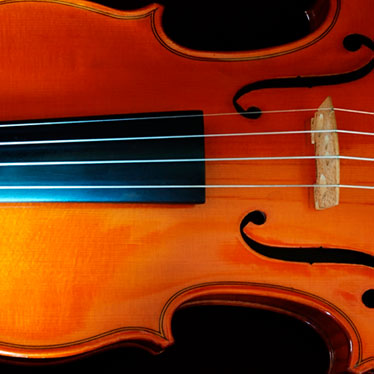How To Care For Your Violin Strings

Your violin’s strings are essential to producing good sound, and that means their care is every bit as important as the care you put into the body of the instrument. From protecting the violin in a case, to choosing the right types of strings and creating a daily care regimen, all defend strings from permanent damage and help them create beautiful, warm, resonant tones.
Use a High-Quality Violin Case
Most of the time we talk about violin cases as a means of protecting the fragile wood body of the violin, but the right case also protects the strings. The bridge of the violin elevates the strings from the body, and this elevated position makes them the first line of defense from direct impact on the front.
Purchasing a high-quality violin case is worth it in every way. In addition to defending your valuable instrument, related tools and accessories, the case also protects strings from being bumped, bonked and tweaked by outside forces as you make your way through the day.
Check out, How to Care For Your Instrument, and learn more about the overall basics of violin and other string instrument care.
Choose the Right Strings for You and Your Lifestyle
As a busy student, your best bet is to use high-quality strings engineered to withstand the rigors of a more rough-and-tumble lifestyle. Student instruments are more vulnerable to the fluctuations in temperature and humidity as the result of transporting them around campus and their inherent indoor/outdoor lifestyle.
Choosing strings that are stronger and more suited to the life of a music student prevents you from continuously replacing string types that are too delicate for academic life. The good news is products such as Alphayue violin strings are affordable, durable and specifically designed to produce amazing sound for their entry-level price.
Read, 5 Tips for Purchasing the Right Violin Strings, for more insight on getting the most life from your string selection.
Make Cleaning Your Strings a Regular Habit
The same things that make your strings sound great - rosin and accurate fingering - cause residue build-up that compromises sound quality if you aren't faithful about cleaning strings regularly.
- Daily: Use a soft, dry cloth (microfiber cloths work beautifully) to wipe the strings off after playing your instrument. Wipe the body underneath the strings as well to protect it from rosin accumulation.
- As needed: In most cases, wiping the strings with a cloth (and not overusing rosin) is enough to prevent rosin build-up. However, if you notice the cloth isn't cutting it, try using a soft, fine piece of steel wool and gently run it along the strings. Beware information recommending the use of alcohol to dampen a cloth; alcohol is a solvent and ruins instrument finishes. You’re better off trusting string cleaning methods that pose zero risk to your expensive instrument.
Tighten Strings With Caution
Beginning violinists love to tune their instrument, but this can lead to damaging strings (not to mention the tuning pegs) if you're not careful. If the strings are loosening to the point that you need to repeatedly use the tuning pegs to tighten them, something is probably wrong (strings were put on or wound incorrectly, bridge slips, severe temperature/humidity fluctuations, etc.).
In most cases, tuning pegs are adjusted sparingly, with the majority of tuning adjustments made using the fine tuners. This prevents the strings from snapping and overusing the pegs.
Change Strings at Least Twice a Year
Changing a violin's strings as needed is the best way to optimize sound and prevent damage or string snapping. How often you change the strings depends on:
- How much you play (most players change every 4- to 6-months, but those who play and perform often may need to change them every 3-months or more).
- String-type (gut-core require changing more often than steel-core)
- Maintenance habits (proper instrument care increases string life)
- Instrument setup (the way your instrument is designed affects how soon strings wear out)
Visit our post, When Is It Time to Change Strings, to gauge whether you should change strings more- or less-frequently.
Strings Need to Warm Up, Too!
We think of warm-ups as something musicians need to do to support their arms, hands, fingers, voices, etc. In fact, new strings need to warm up, too. If you just put on a new set of strings before a performance - or during the performance - the new strings need a warm-up to sound their best.
This involves a series of steps that include tuning, physically warming the strings, vibrating them to help them settle into the bridge, and so on. Watch our video, How to Warm Up New Strings, for a precise demonstration.
Instrument care, including caring for violin strings, is critical to protecting the sound, condition and, most importantly, the life of your violin. Create good habits now, and they'll serve you for a lifetime of happy music making.


